Jesper Schmidt's Blog, page 6
May 24, 2021
Magic Systems Explained
How do you create a magic system for your novel that is both unique and interesting? How do you tackle magic systems when worldbuilding a fantasy setting?
Tune in to episode 126 of the Am Writing Fantasy podcast where Autumn and Jesper share exactly how they create magic systems for their fantasy world.
Tune in for new episodes EVERY single Monday.
SUPPORT THE AM WRITING FANTASY PODCAST!
Please tell a fellow author about the show and visit us at Apple podcast and leave a rating and review.
Join us at www.patreon.com/AmWritingFantasy. For as little as a dollar a month, you’ll get awesome rewards and keep the Am Writing Fantasy podcast going.
Read the full transcript below.
(Please note that it’s automatically generated and while the AI is super cool, it isn’t perfect. There may be misspellings or incorrect words on occasion).
Or you can listen to the podcast! There are several ways …
Subscribe via Apple Podcasts!The podcast player below. Just click play. Or scroll past it to read the full transcript (These are automatically generated and while AI is super cool, it isn’t perfect. There may be misspellings or incorrect words on occasion).On Stitcher, Google Play, Spotify, or your fave podcast app. Just search for “Am Writing Fantasy.”You can listen on YouTube. var podscribeEmbedVars = { epGuid: 'amwritingfantasy.podbean.com/893629b1...', rssUrl: 'http://podcast.amwritingfantasy.com/f...', backgroundColor: 'white', font: undefined, fontColor: undefined, speakerFontColor: undefined, height: '600px', showEditButton: false, showSpeakers: true, showTimestamps: true };
The post Magic Systems Explained appeared first on AmWritingFantasy.
May 17, 2021
What is Deep POV and How Can it Help Your Story?
Do you want to make your characters and writing pop? There are some pro techniques to enhance a character and connect the reader with her/him. One of them is using Deep POV.
Join us for a discussion on Deep POV. What is it? How do you do it? And when are there times you can purposefully not use it? We’ve got you covered in this episode!
To check out the K-Lytics report we mentioned, head over HERE.
And you can check out our book Plot Development HERE.
Tune in for new episodes EVERY single Monday.
SUPPORT THE AM WRITING FANTASY PODCAST! Please tell a fellow author about the show and visit us at Apple podcast and leave a rating and review.
Join us at www.patreon.com/AmWritingFantasy. For as little as a dollar a month, you’ll get awesome rewards and keep the Am Writing Fantasy podcast going.
Read the full transcript below.
(Please note that it’s automatically generated and while the AI is super cool, it isn’t perfect. There may be misspellings or incorrect words on occasion).
Or you can listen to the podcast! There are several ways …
Subscribe via Apple Podcasts!The podcast player below. Just click play. Or scroll past it to read the full transcript (These are automatically generated and while AI is super cool, it isn’t perfect. There may be misspellings or incorrect words on occasion).On Stitcher, Google Play, Spotify, or your fave podcast app. Just search for “Am Writing Fantasy.”You can listen on YouTube. var podscribeEmbedVars = { epGuid: 'amwritingfantasy.podbean.com/3b1440ec...', rssUrl: 'http://podcast.amwritingfantasy.com/f...', backgroundColor: 'white', font: undefined, fontColor: undefined, speakerFontColor: undefined, height: '600px', showEditButton: false, showSpeakers: true, showTimestamps: true };
The post What is Deep POV and How Can it Help Your Story? appeared first on AmWritingFantasy.
May 13, 2021
Inciting Incident
This is where something big happens!
Picking up from the previous post where we talked about the Intro, the next phase in the Seven Steps of Story Structure is the Inciting Incident. This part of plotting and writing your novel is a doozy.
The character’s life gets turned upside down.
It is the first turning point of your story. Sure, that sounds like solid advice, but what do I mean by upside down and how does it relate to the Intro? That is what we are here to pick apart today!
While the Intro should be a snapshot of an average day for the main character, it is centered on a specific action. I call this a mini-short story where the main character is attempting to resolve a problem that most readers would relate to on some level. It isn’t earth shatteringly huge or difficult to grasp. Plus, it allows the main character to interact with the world and other characters in a very real way, one that feels like it has been going on, well, for every day of the character’s life!
All of this allows the reader to gain a sense of familiarity as well as curiosity to see the result of the mini-story that you’ve laid out. All the while, they are gaining compassion for the quirkiness, earnestness, or whatever qualities you lay out in the main character.
The Inciting Incident then is the natural progression to this mini-story. It is its conclusion, and it doesn’t go at all as expected!

For our little farm girl from our example who is searching for the goats her school arch-nemesis has released so that she will miss the subject where they compete, this means the inciting incident will begin with her finding the goats.
There are several possibilities with this scenario:
She finds the goats a great distance from the village in a sacred circle/forest/etc that leads to a new worldShe finds the goats but while she is gone something happens to the villageShe finds the goats but because she missed school, she also missed something importantShe doesn’t find the goats (or they are eaten by something) and must return empty-handed to face the consequencesAny of these will work, but which would work best?
It really depends on where you want the story to go AND what you’ve already shared so far. You start a reader at a single point, with a single word, and then begin to pull them onward with the story. As it spirals out, new layers of familiarity created a foundation. The more often you can refer to the previous incidents in the story, the tighter the weave of the story will be and the stronger it will resonate with readers.
So, in this case, since I’ve already mentioned a school nemesis, the strongest ending to the mini-story is something to do with missing the day of school. The weakest of the four choices is the first, where she ends up in another world that hasn’t been hinted at yet (unless you build in clues during the mini-story of not crossing the stones or wandering into the forest, etc.).
You absolutely want the story to grow logically and with cause and effect that is quickly revealed and easily understood. Such as: if you cross the threshold and into the woods, the witch woman will steal you and change one goat into a doppelganger to return in your place. That would absolutely work and if you laid out hints and warnings prior to the event, it will be a quickly accepted conclusion for the reader.
Or, for the strongest result as I’ve laid out, the girl misses a surprise visit from an arch-mage who is testing the students for abilities in the subject where the goat girl excels. Because she wasn’t there, her arch-nemesis wins the single spot to study something advanced and amazing.
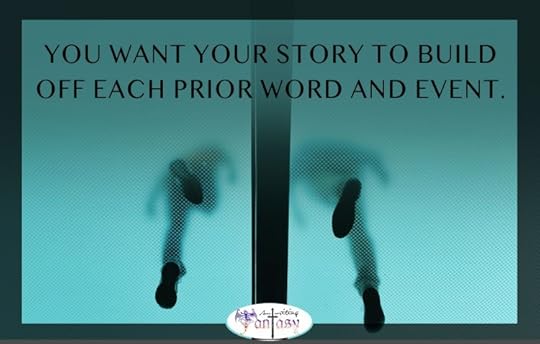
Ok, so that wraps up the mini-story. How does this start the rest of the novel?
Right, you aren’t writing a short story. This is a novel and the result of the inciting incident launches the full novel plot. So, this conclusion MUST be a twist. It must reveal something huge and packs a wallop that the character cannot recover from.
Obviously, if the main character is captured by a witch and taken from everything she knows, that is a pretty big change. So if we go with the idea she finds the goats but because she is absent from school she misses becoming an apprentice to a great mage, what is the part that changes her life? How or why will she not be waking up to deal with the goats the next day, just like she did that morning? That piece will be what links the intro and inciting incident to the rest of the novel.
Does she run after the mage and her arch-nemesis to prove she is better? Does she end up with a different mentor where she doesn’t really belong? Is the wrong rectified but sets up the young arch-nemesis to become the future antagonist to the young main character? Any of these choices could create a solid cause-and-effect scenario that changes the girl’s life.
In fact, that last idea has some strong possibilities. It creates a cause and effect that ripples through the entire book, even if we don’t talk about the arch-nemesis for the next twenty chapters, at least by name. But we’ll come back to that!
First, some things that you should avoid doing with the inciting incident. Absolutely, do not:
Have a repetition of eventsIntroduce something unrelated to the mini-storyHave nothing change from the beginning of the storyFor example, don’t have the girl come back with the goats and have them get out again. Once is enough.
For the second item, don’t have a troll come out of the woods, eat a goat, and scoop up the girl to take back to its lair without having at least mentioned that trolls existed and lived nearby and that they eat children before all of that happens. You want your story to build off each prior word and event, not run off in quick jumps that seem exciting, but where nothing grows out of the beginning.
And for the last advice, do not have the girl waking up and sullenly going about tending the goats the next day as her rival gets to head off to a life of adventure. Something far more exciting needs to happen or you’ll lose some readers. The character should cannot go about living their ordinary life. Whatever happens is all-consuming. Either everyone they know is dead and the village burned to the ground, they are caught somewhere far from home and unable to return, they must flee everything they know for the safety of others, or they simply have been awakened to something far greater than they knew was possible and they cannot go on with how life was previously.
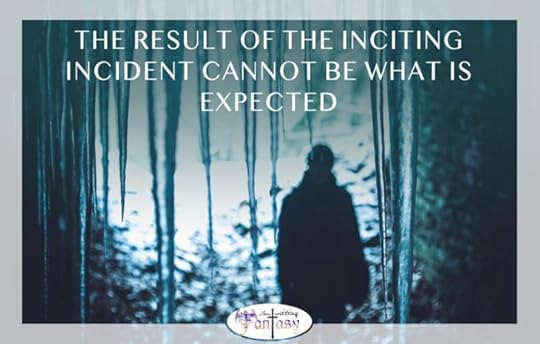
THAT is what is meant by an earth shattering event.
So for our example in the intro, we sent a young girl out after goats her arch-rival let loose on purpose. The result, the end of the mini-story and beginning of the inciting incident, is that the girl then misses the visit of a great mage who chooses the nemesis as a new apprentice, as her little brother happily tells her. The girl loses the chance to gain the knowledge and guidance she desperately wants, as well as is robbed of the acknowledgement that she is extremely gifted.
That injustice, really all the petty injustices she has put up with up until this point, culminate with the fact that her arch-rival was just awarded the spot she should have gotten and not even her favorite teacher stood up for her. That pushes her just one step too far.
The final result, the full inciting incident, is that the girl dashes to the school and demands to see the arch mage; she demands to be tested too. And as they tell her it is too late, the budding power she is harboring blazes to life, resulting in a force she can’t control — nor can her smug (and suddenly very scared) rival.
The arch mage manages to cool things down with only a few injuries, like the external (and internal) scars the rival will carry. Wondering where the girl has been spills enough of the story that the girl will be awarded her place, but… she’s pushed too far too soon and injured others.
The result cannot be what is expected — that all is made right, and she is the apprentice. THAT would too easy and the one thing you can never hand a reader is a solution that is too easy.
Instead, the girl is sent far away where her wild gifts will not harm others. The rival is left home to heal and maybe will be selected for a different spot… After all, she didn’t do anything really that wrong and was the second most talented at the school.
As long as there were hints about rules in this society that could not be broken (such as harming others) and magic that could not be used (in an uncontrolled manner) in the beginning, this will all make sense. Well, not to the little goat girl who just lost everything and has to deal with that fact.
Which will bring us to the next phase in a future post!
For more tips on plotting, check out our Plot Development Book! Learn not only how to plot, but how to create characters, align them with character arcs, and tie the character’s journey with your plot to create tension filled, character-driven fiction!
The post Inciting Incident appeared first on AmWritingFantasy.
May 10, 2021
Will Social Media Actually Help to Sell Books?
Perhaps you’ve asked yourself more than once whether or not social media actually sells any books? Is it worth the time and effort you put into to schedule and post new stuff on Facebook, Twitter, Instagram etc.?
In this episode of the Am Writing Fantasy podcast, Autumn and Jesper share their personal experiences and provides an answer as to whether you’re better off spending your time writing or if social media is actually a good thing.
Tune in for new episodes EVERY single Monday.
SUPPORT THE AM WRITING FANTASY PODCAST! Please tell a fellow author about the show and visit us at Apple podcast and leave a rating and review.
Join us at www.patreon.com/AmWritingFantasy. For as little as a dollar a month, you’ll get awesome rewards and keep the Am Writing Fantasy podcast going.
Read the full transcript below.
(Please note that it’s automatically generated and while the AI is super cool, it isn’t perfect. There may be misspellings or incorrect words on occasion).
Or you can listen to the podcast! There are several ways …
Subscribe via Apple Podcasts!The podcast player below. Just click play. Or scroll past it to read the full transcript (These are automatically generated and while AI is super cool, it isn’t perfect. There may be misspellings or incorrect words on occasion).On Stitcher, Google Play, Spotify, or your fave podcast app. Just search for “Am Writing Fantasy.”You can listen on YouTube. var podscribeEmbedVars = { epGuid: 'amwritingfantasy.podbean.com/3d315a88...', rssUrl: 'http://podcast.amwritingfantasy.com/f...', backgroundColor: 'white', font: undefined, fontColor: undefined, speakerFontColor: undefined, height: '600px', showEditButton: false, showSpeakers: true, showTimestamps: true };
The post Will Social Media Actually Help to Sell Books? appeared first on AmWritingFantasy.
May 4, 2021
Build a fantasy world while growing your story
Fantasy worlds are AWESOME!
It could be argued that a fantasy story without an amazing world just doesn’t feel like fantasy. Fantasy as a genre can be defined as a story that has a fantastical setting and magic. The rest — swords, wizards, dragons, and all that — aren’t really necessary. Even if I might argue about keeping dragons… 
The point is, readers of fantasy expect amazing worlds and magic. And if you don’t deliver, they’ll let you know. Usually in reviews… you know, right where it hurts. 
So, how do you go about creating a world that is at once unique (so memorable) but not so different as to be alienating? How do you craft it without getting lost in histories, developing cultures, and breeding monsters to challenge your heroes? Wouldn’t it be better if you could worldbuild a setting designed for the story you want to write? And maybe grow that story along the way, so that in the end you have not only a unique world PERFECT for your story but also a bit more to add to the plot and characters, and even know the magic of it like a mage?
If that makes your heart flutter, have I got some news for you!
Yes, it is possible to create an amazing world while seeding your story within it until the two are inseparable. But you won’t find it on the worldbuilding question list you just googled. We know that because we googled them ourselves … probably just about all of them.  And we couldn’t find what we were looking for!
And we couldn’t find what we were looking for!
There was nothing that would develop a world just enough to make it feel fully formed but without spending months and months creating it while struggling not to get too carried away with the fun of worldbuilding. Not one that would fit a story that grew with the world, forming something unique and rich.
So we creating something that would.
And now, for the first time to the public at large, we are releasing our fantasy worldbuilding course, Crafting Incredible Fantasy Worlds! We are so excited to share this course with you! If you’ve listened to the Am Writing Fantasy podcast, you know we took YEARS to create this course and even tested it out by building a world, and now are writing a series, using the techniques we teach in it. The good news is it works!
So if you want to grow amazingly rich worlds without getting lost or shortchanging the time you need to write a story, if you want to cover elements you might not have thought of, learn to weave the worldbuilding and story together, and bring your world to life beyond a list of a hundred or so questions, check out Crafting Incredible Fantasy Worlds on its first public launch!
But hurry, the course is only open until May 8th. After that, we’ll close the doors and welcome our new students. We hope you join us!
The post Build a fantasy world while growing your story appeared first on AmWritingFantasy.
May 3, 2021
Top 10 WORST Fantasy Worlds
An awesome fantasy world can make a story — just as a terrible or terrifying one can make you run for a different book. Join Autumn and Jesper as they go head to head to come up with the worst fantasy world… or figure out how to create a story out of some pretty horrifying recommendations.
If you want to check out the Story Idea book Autumn and Jesper mention in the podcast, head over to https://books2read.com/StoryIdeas (and check out the brand new audiobook that was just released!).
OR pick up the Plot Development book and get a free ebook copy of Story Ideas at https://books2read.com/Plot-Development.
Tune in for new episodes EVERY single Monday.
SUPPORT THE AM WRITING FANTASY PODCAST!
Please tell a fellow author about the show and visit us at Apple podcast and leave a rating and review.
Join us at www.patreon.com/AmWritingFantasy. For as little as a dollar a month, you’ll get awesome rewards and keep the Am Writing Fantasy podcast going.
Read the full transcript below.
(Please note that it’s automatically generated and while the AI is super cool, it isn’t perfect. There may be misspellings or incorrect words on occasion).
Or you can listen to the podcast! There are several ways …
Subscribe via Apple Podcasts!The podcast player below. Just click play. Or scroll past it to read the full transcript (These are automatically generated and while AI is super cool, it isn’t perfect. There may be misspellings or incorrect words on occasion).On Stitcher, Google Play, Spotify, or your fave podcast app. Just search for “Am Writing Fantasy.”You can listen on YouTube. var podscribeEmbedVars = { epGuid: 'amwritingfantasy.podbean.com/3f6ebe45...', rssUrl: 'http://podcast.amwritingfantasy.com/f...', backgroundColor: 'white', font: undefined, fontColor: undefined, speakerFontColor: undefined, height: '600px', showEditButton: false, showSpeakers: true, showTimestamps: true };
The post Top 10 WORST Fantasy Worlds appeared first on AmWritingFantasy.
April 26, 2021
Latest Trends and Niches in the Fantasy Book Market (with Alex from K-lytics)
Do you want to sell more books, face less competition, and achieve a higher return on your publishing investments?
K-lytics has the answers and this episode of the Am Writing Fantasy podcast, Jesper talk to the owner of K-lytics, Alex, to gain a better understanding of what K-lytics is and what the latest trends and niches are within the fantasy genre.
Learn more about K-lytics here: https://k-lytics.com/
Tune in for new episodes EVERY single Monday.
SUPPORT THE AM WRITING FANTASY PODCAST!
Please tell a fellow author about the show and visit us at Apple podcast and leave a rating and review.
Join us at www.patreon.com/AmWritingFantasy. For as little as a dollar a month, you’ll get awesome rewards and keep the Am Writing Fantasy podcast going.
Read the full transcript below.
Or you can listen to the podcast! There are several ways …
Subscribe via Apple Podcasts!The podcast player below. Just click play. Or scroll past it to read the full transcript (These are automatically generated and while AI is super cool, it isn’t perfect. There may be misspellings or incorrect words on occasion).On Stitcher, Google Play, Spotify, or your fave podcast app. Just search for “Am Writing Fantasy.”You can listen on YouTube.
var podscribeEmbedVars = { epGuid: 'amwritingfantasy.podbean.com/ee6fe144...', rssUrl: 'http://podcast.amwritingfantasy.com/f...', backgroundColor: 'white', font: undefined, fontColor: undefined, speakerFontColor: undefined, height: '600px', showEditButton: false, showSpeakers: true, showTimestamps: true };
The post Latest Trends and Niches in the Fantasy Book Market (with Alex from K-lytics) appeared first on AmWritingFantasy.
April 23, 2021
Your Story’s Introduction
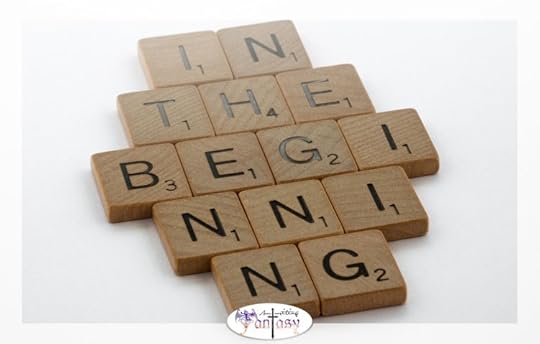 Story Structure Step 1: The Introduction
Story Structure Step 1: The IntroductionFirst, what is it, and how long should it be?
So, yes, the introduction really does what it says: it introduces a reader to your story, world, and characters. There is a lot going on there!
From a reader’s perspective, it should be exciting, informative, spark a connection with the main character, and at the very least make them curious about the rest of the book. All of that must exist without overwhelming or being too unfamiliar. And, of course, it has to be grammatically strong enough they aren’t groaning on every page as they roll their eyes at obvious mistakes. Miss any of those things in your introduction, and you’ll lose the reader if not the sale.
Wait! What? The sale???
Yes, the introduction comprises the first one to three chapters, or about the first 15%, of your novel. So, this is a large part of what readers can download as a free sample or see online. Suave readers will be looking at this piece of your book to decide if they want to buy it. Keeping that in mind is an important part of the final stages of edits to the introduction.
And yes, final stages! Absolutely do not try to make your introduction perfect before you finish writing your darn novel.
I’ve witnessed way too many novice authors get lost and bogged down creating the perfect introduction because nailing this part is such a huge aspect to writing a story. Don’t get lost in a cycle of edits to improve something that you won’t really be able to judge how it relates to the end ending until, well, you write the end!
What Should Happen in the Introduction?As writers, our perspective of what should happen in an introduction is a list of advice and ideals to hit:
Have a great opening lineBut don’t make it about the weather or descriptionStart with actionIntroduce the main characterIntroduce your awesome worldIntroduce a problemProvide background so the reader isn’t lostMake sure you describe things well enough the reader has some visualsDon’t info dumpAre you hyperventilating yet? It can feel completely overwhelming to tackle even two of those items in an average chapter. Try stuffing it all in a chapter or three and you might just never finish writing. Which is part of why I say don’t worry about it. Not until you finish your story.
Until you finish writing, you might not know really how the story should begin, especially if this is your first novel. I know for my first novel, I cut off three chapters before I found the beginning that I thought worked. The other three made sense, but they were too boring, too slow, filled with too much background. They didn’t matter, and they certainly didn’t hook a reader.
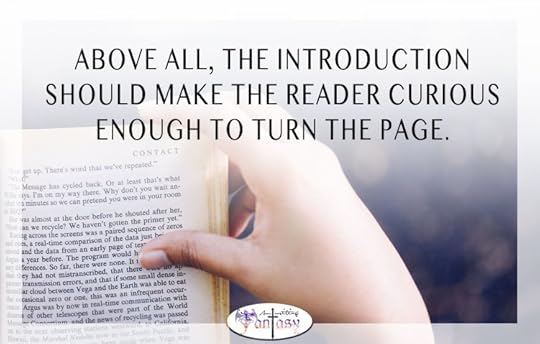
You have to trust that the reader will be able to catch on if you provide enough clues. And all you want to do is provide that bread trail that leads them onward. Give them enough so they are curious to see where the path goes, but not so much that they know the end or every detail of every leaf they are walking over. Either of those will lose them.
And for a first time writer, you might not realize who actually is the main character, what events are pivotal, or how your character needs to change until you get your first draft finished. A lot of having confidence in what you are writing is what needs to be there comes after you’ve written many, many stories. For your first few, just write, plot, and pay attention to see how things develop.
Advice for Your IntroWhether you plot out the Intro before you write or come back to it to edit after finishing, there are a few things that can help you lay the foundation to something solid.
My biggest and best advice for a great intro is to think of it as a short story. Actually, think of it as a mini-short story that is the setup for the REST of the novel.
In other words, it doesn’t deal with the big novel plot, the major events of the character arc, or any of that. It is, instead, a snapshot of the character before anything overwhelming happens to set them off on the realizations and troubles that occur in the rest of the novel.
If your main character hopes and pines for a way to leave their dreary life, that is what the reader will see. If she is a perfectly content and happy child, that is what you should reveal. If there is hidden injustice, discontent, or something amiss, it should leak around the edges of your character’s average day (unless their entire life is dedicated to fighting it, which is a bit of an odd and heavy start to a fantasy story, but you could manage it with a bit of practice!).
These issues aren’t the key events that the mini-story revolves around; they just lay clues the reader shouldn’t even realize are important until later events bring them to the fore.
So what do you focus on?
Like a short story, there should be something going on that the character needs to solve. It shouldn’t be anything earth shattering or be connected to the over-arching novel plot about to unfold. Instead, it is on the level of the goats that the farm girl is responsible for got out because her childhood arch-nemesis unlatched the gate just to make the girl late for school. Because this girl, our little heroine, is the favorite pupil in the arch-nemesis’ favorite subject and favorite teacher. You know, the one class the arch-nemesis wants to be the best at.
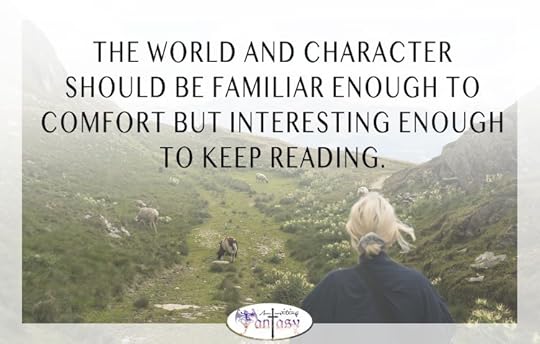
And in that brief outline, what did I give you? Can you feel what this girl’s average day is like? A bit about what her world is like? Who she is? That is the level you want to give your reader.
The world should be the backdrop to this completely ordinary day and not center stage. Only share what you must so that the reader knows the girl’s age, how many goats she is responsible for, if her mother or father blames her for their escape. Does her brother laugh as he skips off to school while she trudges off along the muddy road with a rope?
Show the character in a kind, decent, interesting, whatever enough that the reader cares for him or her. Reveal enough of the world that it feels real, but also familiar despite it being somewhere fantastical. You have the entire novel to show the differences. In the first few pages, focus on commonalities to this world and not the differences. In the above example, that is:
schoolfrenemiesmud (weather)choresirritating siblingsWith those foundation stones, you assure the reader that this world is amazingly vivid while soothing them that it is also familiar and won’t leave them so confused they feel lost. They’ll care for and understand the character while glimpsing the world at large.
And, if you write it real enough, they’ll be curious to see how this little adventure goes so that they’ll read a few more pages to find …
Well, we get to that soon! 
The post Your Story’s Introduction appeared first on AmWritingFantasy.
April 19, 2021
Thoughts, Tips & Tricks, on ProWritingAid
Over the past few months Autumn and Jesper have tested out different types of writing software. Against AutoCrit and Fictionary, your hosts decided that ProWritingAid is the best one of them all.
In this episode of the Am Writing Fantasy podcast, Autumn and Jesper (well, mostly Autumn), explains why ProWritingAid is such a great support tool for authors.
Sprinkled in are tips and tricks, you can take away and apply in your own writing process.
ProWritingAid can be found here: https://prowritingaid.com/
Tune in for new episodes EVERY single Monday.
SUPPORT THE AM WRITING FANTASY PODCAST!
Please tell a fellow author about the show and visit us at Apple podcast and leave a rating and review.
Join us at www.patreon.com/AmWritingFantasy. For as little as a dollar a month, you’ll get awesome rewards and keep the Am Writing Fantasy podcast going.
Read the full transcript below.
(Please note that it’s automatically generated and while the AI is super cool, it isn’t perfect. There may be misspellings or incorrect words on occasion).
Or you can listen to the podcast! There are several ways …
Subscribe via Apple Podcasts!The podcast player below. Just click play. Or scroll past it to read the full transcript (These are automatically generated and while AI is super cool, it isn’t perfect. There may be misspellings or incorrect words on occasion).On Stitcher, Google Play, Spotify, or your fave podcast app. Just search for “Am Writing Fantasy.”You can listen on YouTube. var podscribeEmbedVars = { epGuid: 'amwritingfantasy.podbean.com/0e7fc1c1...', rssUrl: 'http://podcast.amwritingfantasy.com/f...', backgroundColor: 'white', font: undefined, fontColor: undefined, speakerFontColor: undefined, height: '600px', showEditButton: false, showSpeakers: true, showTimestamps: true };
The post Thoughts, Tips & Tricks, on ProWritingAid appeared first on AmWritingFantasy.
April 16, 2021
Join the Get #Worldbuilding Help giveaway!
Lost in building a world when you know you really want to write a story… if you could just sort out the setting? Not to mention how the magic works? Or once you figure out the history… religions… cultures…
Don’t worry, we’ve got your back!
We are two bestselling fantasy authors who’ve not only created numerous worlds, Autumn’s won Best Worldbuilding in 2017. Now we want to help you tackle the labyrinth of building the world of your story! One winner will receive a 45 minute Zoom mentoring session to help steer you through your worldbuilding and bringing it to life in your story!
Plus ALL entrants will receive an illustrated guide to creating a continent! Just sign up below (or follow THIS link if you don’t see the form). The giveaway runs from April 16 until the 30th!
The post Join the Get #Worldbuilding Help giveaway! appeared first on AmWritingFantasy.




